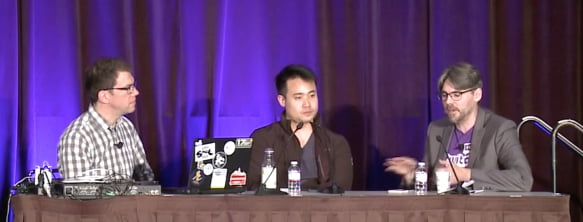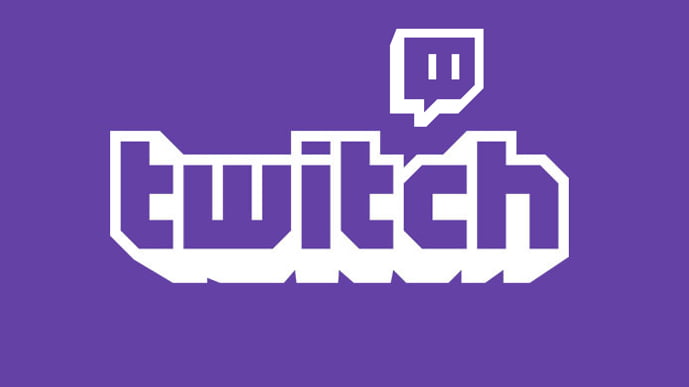If you are an indie developer and want to promote your game, it goes without saying that you need to be on Twitch, right?
Since Twitch launched in 2011 it has grown to over 100 million visitors per month and is a key channel used for the marketing of games. However, being such a crowded platform, building an audience is not without its challenges. Overcoming these hurdles was the subject of an Amazon sponsored talk at last month’s GDC. And although primarily aimed at developers, many of the recommendations were also relevant for wider Twitch broadcasting audience.
The panel included Garnet Lee, once of EGM and now gaming evangelist at Amazon, plus Twitch’s director of publisher and developer partnerships, Ernest Le, and director of programming, Marcus Graham.
Unsurprisingly, a commitment to engagement and interaction are the key to making the promoting your game on Twitch.
“With something like video interaction, that was introduced with Twitch you create a two-way environment where you get fans to connect with your brand, game or community better because they’re communicating with you, “ says Graham. “They’re communicating with each other and they’re communicating with people who have similar interests.”
This method of audience communication is far removed from the one-way messaging days of old based press release reports, and magazine coverage.
“Every moment that you’re live and someone is interacting with you, or your game, they are becoming part of a two-way fanbase,” says Graham.
It’s no walk in the park, however, and requires some thought if you are to make the most of video broadcasting. The hardest thing to do, as a developer, is determine why someone would want to watch your game. How do you get people attracted to your title and then hooked?
According to Lee, the hook is the thing that makes interacting on Twitch fun.
“There’s nothing nefarious about it,” he says “Your fans genuinely want to be involved in that way.”
For some games the hook is obvious. Titles such as Starcraft, Counterstrike, League of Legends, and DOTA 2 have two things in their favour: they are competitive and – in general – never have an end-point.
“There’s a reason to keep playing because you can never truly master one of these games,” says Graham. “And having human competition will always bring players back.”
Perceived wisdom is that story-based games will generally not have a long lifecycle on Twitch. Once it’s done, it’s done. But there are exceptions. Recent hit Stardew Valley has been a consistent presence in the Twitch Top Five in recent weeks.
“There is something to be said in the way that Twitch broadcasters are embracing that game in that when they add new animals they might be named after a user that’s watching the game,” Graham explains. “Or they might name the city based on what the chat says. They’re creating interaction in a game where technically there is no interaction design.”
The takeaway is to think about how you can add interactivity to your broadcast, even if your game is not an immediately obvious fit.
“It is becoming harder and harder to say this is a game that will last a long time and this is a game that won’t,” says Graham.
For Graham, interaction is at the core of what makes a game work on Twitch.
“If you go in expecting it to be a one way experience, you’re doing it wrong,” he says. “If you’re an average viewer and this is the first time you’re being exposed to an IP – I’ve seen individuals get a key to a game on Steam – and they just become a champion for that game.”
Graham’s advice is to look at what other successful streams are doing and dedicate some time to understanding how they work. It’s not necessary to copy or emulate everything but you will get a feel for the best approach and what works.
“There’s so much to be learned from the broadcasters who are basically perfecting the craft and doing it full-time as their job,” says Graham.
It also pays to tie in your interactivity with the mechanics and selling points of a game.
“What is the game all about? What is the experience all about? Each one of those questions is important in figuring out what your strategy is going to be,” explains Graham.
“If you have a time, or score-based game, that doesn’t have multiplayer aspects it can still be interactive in that you can encourage broadcasters and streamers to post their best times or scores.”
Understanding what your audience does with your game is also useful, says Le. It can help you figure out why people want to share your game and why people want to watch in the first place.
“The first point is what do players who play at the highest level do?” he asks. “Detect that, figure it out. It could be that they love dungeons. Or they love grinding or getting gear. Extract that and think how to apply that to broadcasts and viewers.”
Secondly, says Le, it doesn’t hurt to think of your game as an eSport.
“What do players who are the best do? Hone in and capitalise on what the best players are doing to create content ideas.”
As it turns out, viewers like watching players do things they can’t. This could involve watching someone beat The Four Kings in Dark Souls – or it could just involve watching someone loot.
“In Counterstrike viewers would watch people open up cases and cases of stuff,” says Le. “Again, it’s aspiration. If I’m 17 years old and can’t spend $500 on a case, I can watch that – and maybe have a chance to win that.”

In addition to the content of a Twitch broadcast many developers have concerns about production values. Often these fears are misguided, says Graham.
“I’ve seen the most crude streaming set-ups yield tens of thousands of viewers,” he says. “That whole DIY thing is accepted. It’s something to keep in mind that you don’t need to put $150,000 into the investment of a studio to make the most amazing content in the world.”
The only exception to the rule it seems, is audio.
“Make sure your sound is good, that’s important,”says Graham. “But otherwise, they want to see the game, they want to see the content and they want to hear from you as an individual – who they don’t normally get to hear from.”
So, how do you start? There are two approaches. For Garnett Lee the best way to get a feel for Twitch is to dive in and start using it.
“Just jump in,” says Garnett Lee. “My experience with twitch has been awesome as a viewer and broadcaster. Just how enjoyable it is to make friends in the Twitch community, to get on and stream and chat with folks. It has more sense of genuine social interaction in the virtual world than any other platform I’ve seen.”
However, if you are a developer it also pays to think about your approach before getting started.
“We used to preach ‘just start creating content’,” says Le. “I think that was probably the biggest mistake we made because it’s so easy to invest so much time and effort and not figure out where you’re going. I think talking a step back and really figuring out what you want your message to be, and why you want to create an hour of content vs. ten hours of content, and why would someone want to watch the two scenarios. Now we say, what’s your message? What do you want to do? What’s your goal?”
Ensuring each broadcast has a particular focus or theme can also help. Just as you wouldn’t build a game without a design document, planning what you want to examine in each broadcast can really help structure your content and engage viewers.
“You have to figure out who your target audience is on a day-by day-basis,” says Le. “My advice is don’t mash too many topics into one broadcast because you’ll get a confused user base.“
To conclude, Graham emphasises that the audience wants what you – as a developer – have. If you can display your passion, you can bring an audience with you.
“Don’t let that first experience scare you away,” says Graham. “It does take practice. It does take a little bit of changing the way you think about the content and interaction with the audience. Keep in mind who that audience. They want this stuff from you, that want to hear from you. They want more insight from you about the things you’re making.”






